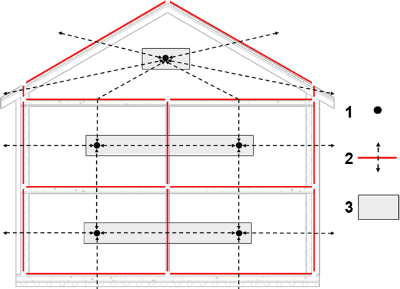An energy model is a special form of geometry used for energy simulation engines such as DOE 2.2 and EnergyPlus. The energy model powers Energy Optimization for Revit.
The energy model is an abstraction of a building's overall form and layout into a computational network. This network captures all of the key paths and processes of heat transfer throughout the building.
Based on the gbXML schema, the energy model has 3 main components:
- Spaces are discrete volumes (masses) of air that experience heat loss or gain. These heat changes are due to internal processes like occupancy, lighting, equipment, and HVAC, as well as heat exchange with other spaces and with the exterior environment.
- Surfaces are the paths of heat transfer to or from each space, including surfaces between interior spaces and the external environment.
- Zones are groups of spaces used to establish some commonality between those spaces. For example, zones may represent spaces with the same orientation, the same function, or service by the same HVAC system.
For example, the following illustration shows spaces (1), surfaces (2), and zones (3) as a computational network in the energy model.
